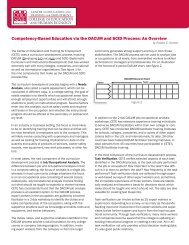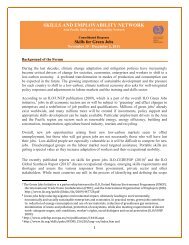FACTORS AFFECTING THE PERFORMANCE OF WOMEN ENTREPRENEURS IN MICRO ...
FACTORS AFFECTING THE PERFORMANCE OF WOMEN ENTREPRENEURS IN MICRO ...
FACTORS AFFECTING THE PERFORMANCE OF WOMEN ENTREPRENEURS IN MICRO ...
Create successful ePaper yourself
Turn your PDF publications into a flip-book with our unique Google optimized e-Paper software.
CHAPTER ONE<br />
<strong>IN</strong>TRODUCTION<br />
This chapter addresses the introductory part of the research. It basically includes<br />
background of the study, statement of the problem, purpose and significance of the study,<br />
delimitation of the study, limitations of the study, and definition of basic terms.<br />
1.1 Background of the study<br />
Entrepreneurship is increasingly recognized as an important driver of economic growth,<br />
productivity, innovation and employment, and it is widely accepted as a key aspect of<br />
economic dynamism. Transforming ideas into economic opportunities is the decisive<br />
issue of entrepreneurship. History shows that economic progress has been significantly<br />
advanced by pragmatic people who are entrepreneurial and innovative, able to exploit<br />
opportunities and willing to take risks (Hisrich, 2005).<br />
The role of entrepreneurship and an entrepreneurial culture in economic and social<br />
development has often been underestimated. Over the years, however, it has become<br />
increasingly apparent that entrepreneurship indeed contributes to economic development.<br />
Nevertheless, the significant numbers of enterprises were owned by men (ILO, 2006). In<br />
other words, it was not common to see women-owned businesses worldwide especially in<br />
developing countries like Ethiopia. The idea and practice of women entrepreneurship is a<br />
recent phenomenon. Until the 1980’s little was known about women entrepreneurship<br />
both in practice and research, which made its focus entirely on men. Scientific discourse<br />
about women’s entrepreneurship and women owned and run organizations is just the<br />
development of 1980s (ILO, 2006).<br />
Even though we observe a number of women entrepreneurs in the business, recent studies<br />
show that most of them are found in Micro and Small Enterprises(MSEs). According to<br />
the Ethiopian Central Statistics Authority (2004), almost 50% of all new jobs created in<br />
Ethiopia are attributable to small businesses and enterprises, and roughly 49% of new<br />
businesses that were operational between 1991 and 2003 were owned by women.<br />
1
















